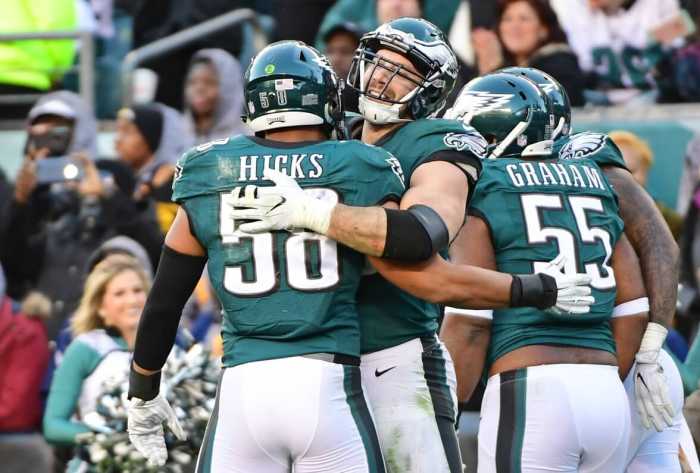In this installment of Know your Eagles Enemy, we’re switching it over to the defensive side of the ball. Over the next week, we’ll get to the bottom of the Dallas defense and try to figure out if they’re for real or in trouble. Let’s get started.
The Dallas defense has been a middling unit for what seems like a decade, apart from an incredible 2016 season. Every Cowboys fan will have a round-about argument for why their young defense is underrated. The truth is this group has more excuses than results. I’ve read multiple articles that point to Dallas being the “best defense in the NFL over the last month of the season”; in which they allowed an average of 12.4 points, 166.4 passing yards, and 280.9 total yards a game. They played: an awful NYG offence; an Oakland offence that never put it together; a wouldn’t-call-it-explosive Seattle offence; and the Philadelphia farm team. While it is important to understand that Rod Marinelli has deployed a “bend-but-don’t-break” defense since he took over in Arlington in 2014, at some point this defense needs to step up in a big way to be considered among the upper echelon.
In 2017, the Dallas run defense was a top 10 finisher (1,664 yards against, good for 8th place; 7 rushing TDs allowed, 3rd best). However, they were the worst defense in the league on third and short, and on second down rushes. Their pass defense was also a mixed bag. The young group ranked 11th against the pass managing 3,425 passing yards against (214.1 yards per game), but allowing 28 touchdowns through the air, tying with the Cleveland Browns for 26th. They also allowed an average completion percentage of 66.37% to opposing quarterbacks. This list includes Carson Palmer and CJ Beathard, who did their best to drive the average down. The secondary only managed 10 interceptions (24th). I imagine Marinelli is more concerned with the 28 touchdowns than the completion percentage, but his defense seems to be doing a lot of easy bending. That being said, there are definitely some bright spots to build upon in 2018. If every disappointing or derelict defender dons his difference-maker pants for the new season, the Dallas defense could be more than just a tantalizing tale of what-ifs.
Defensive Line
Over the past few years, the Dallas defensive line has been less than a sum of its parts. Whether through suspension or injury, or multiple suspensions followed by an exile and a lengthy court process for reinstatement, Dallas has yet to field a complete d-line for a full season. The unit finished tied for 15th in sacks with the Eagles. The difference being, the Eagles led the league in hurries, and were the only team in the NFL to register pressure on over 40% of opponents pass plays. The shining star of 2017 was defensive end Demarcus “Tank” Lawrence, finishing the season with 58 total tackles and tied for a second-place finish in the sack race, with 14.5. Evaluation on Lawrence can be difficult as he missed most of his 2016 season and 2014 rookie season due to injuries or suspension.
Notably, he has missed time for a nagging back injury which forced him into two off-season surgeries in 2015 and 2016. In his relatively healthy 2015 season he managed 55 total tackles and 8.0 sacks in 13 starts. He might never be commended for his talents as a run-stopper, but perhaps that is one of the underrated facets of his game. This is overshadowed by his unique ability as a pass rusher. Last season, according to Pro Football Focus, Lawrence registered 79 pressures (3rd best in the league) on 454 pass rushes for a league best 14.8% pass rush productivity. This is up from his 46 pressures in 2015, a significant sign of improvement. He clearly has the talent to be a top flight defender, but there’s a reason he hasn’t been offered a long-term contract. Whether he takes it as motivation, or crumbles under the pressure, “Tank” will play under a $17 million franchise tag for the 2018 season. If he’s able to stay on the field, he has provided analysts with two consistent seasons, albeit with different sack totals.
A successful season on the d-line will depend on how much help Lawrence gets from his defensive line partners. In 2017, he made 39 splash plays according to Bob Sturm of SportsDay. The next most active Dallas lineman was David Irving with 18.5. I bring this to your attention because over the course of the 2017 season, habitually playing on the left side of the defense, Lawrence faced very few top tier tackles. Right tackles have become a more valued position in the NFL over the past few seasons, and in 2018 Demarcus may see more attention paid to him.
When he faced Lane Johnson in week 11, he registered no sacks, 2 tackles and one knocked down pass. There’s an 8 minute video of them competing below. He also registered no sacks and two tackles against Kansas City’s Mitchell Schwartz. With the reactive nature of the league, and the successes of left defensive ends around the league – Lawrence, Brandon Graham, Joey Bosa – bet on teams addressing the right side of their line in a big way. In 2018, if teams aren’t turning over rocks looking for talented right tackles, then they’re sending tight ends and running backs to chip, or running pulls and screens to slow down the pass rush from the suddenly dangerous right side. You heard it here first.
At 1:34 you’ll see two plays that showcase his run stopping ability.
Maliek Collins will most likely start beside Lawrence at 1-technique defensive tackle. Collins is a steady pocket pusher, despite being slightly undersized at 6’2” 308 pounds. While he won’t wow with his splash plays, he is one of the few Cowboys along the defensive line that can stay on the field for 16 games. He has been sidelined with a foot injury requiring surgery during the off season, which could be something to keep an eye on.
If he returns fully healthy, Collins may have an opportunity to return to 3-tech defensive tackle, where he spent his rookie season in 2016, with David Irving being sidelined due to suspension. In 2016 Collins had 5.0 sacks, double what he had last season. Physically, he better fits the bill as a 3-tech and could see an up-tick in his success if he reprises his role this season. Forcing an undersized body to man the 1-tech could be why Dallas was 32nd in the league on third and short in 2017. I would be surprised if a big run-stopping 1-tech wasn’t at the top of Jerry Jones’ 2018 draft day wish list.
His defensive tackle partner is a much more polarizing player – think yin and yang, Dr. Jekyll and Mr. Hyde. David Irving played end in 2016, but bumped inside last year for the eight games that he played. He has already been passed down a 4 game suspension from the league for violating the NFL’s substance abuse policy, so we’ll have to wait a few weeks to even see him on the playing field. He received the same suspension in 2016. This is amidst concerns from Jason Garrett and Marinelli that he is not in playing shape and an on-going investigation for domestic violence allegations in April, which has now been closed. Needless to say, maturity is a concern for the 24 year old.
On the field, Irving is a 6’7” 290 pounder that displays incredible athleticism for his size. He registered 7.0 sacks in 8 games last year, and before he was ruled out for the season due to concussion, he was leading all DTs in that category. He is more of a reactor than a mover and can get caught up against quick lineman, but has great instincts, and will make important plays. Against Green Bay in 2016 he was named the defensive player of the week after registering three tackles, three forced fumbles, a fumble recovery, and a passed defensed in 19 snaps. Games like these appear to show flashes of the potential play-maker Irving could be – when he plays.
https://youtu.be/zTtixyya9zM?t=1
In the first clip, Irving demonstrates his speed out of the 3-tech.
Based on what the Cowboys decide to do at DT, Tyrone Crawford may play one of many positions along the d-line this season. Looking at what he has been able to accomplish in his first five seasons, you might be surprised to hear that Crawford is paid like a top-10 defensive end. While he has played all over the line in his career, he plays best as a 3-tech as he did in 2015. This mostly stems from the fact that he’s just not fast enough to win speed battles off the edge. Tagged as a project player coming out of college, he hasn’t played a particular position long enough to master it. Perhaps he will do enough in David Irving’s absence to earn the starting 3-tech position. Otherwise he should be a solid rotational piece with last year’s first round draft pick Taco Charlton.
| Tyrone Crawford | Position | Total Tackles (Solo Tackles) | Sacks |
| 2015 (16 Games) | DT | 34(23) | 5.0 |
| 2016 (14 Games) | DE/DT | 29(16) | 4.5 |
| 2017 (16 Games) | DE | 27(18) | 4.0 |
Former draft picks along with some off-season acquisitions will also be looking to add a significant spark to Dallas’ defensive line rotation. The Cowboys will be expecting a second year jump from Taco after a rookie season full of promising flashes. At 6’6” 270 pounds, Charlton is a long, rangy, athletic end with quick first step and a good motor. He came by most of his sacks last year by endlessly working towards the quarterback, using his length and speed to keep tackles at arm’s length. He isn’t known to out-muscle opponents, but he has the ability to push the pile and can overwhelm blockers with his speed. Touted as an end with a nasty spin move and a full arsenal of pass rush moves coming out of college, he struggled early against the league’s left tackles and was bumped to the left side of the defense. With a full off-season to develop some NFL level counter moves, he could very well return to the right side with a vengeance.
https://youtu.be/SAHdtVFQ3PQ?t=64
At 0:18 you’ll see Taco’s ability to push the tackle, using his length to get leverage. He quick first step and motor against KC at 1:04.
The easiest way to project Taco is to compare him to Eagles’ 2017 first round pick Derek Barnett. You’ll see that their stats are similar; the difference is that DB showed more ability to create for himself in his first year. To be fair, that’s an easy task when every other player on the line demands a double team. Barnett also displays better ability stopping runs. The third difference is one of physical build. Taco fits the bill for the long, lean ends that Dallas has coveted, DB fitting the shorter, stout build that Philadelphia has utilized. Otherwise, provided both young ends stay on their respective trajectory paths, their careers will be rife with comparison. If he is supported by quality rushes by his line-mates, Taco is a hard man to keep away from the quarterback. He also ended his first season on a high note, having his three best pass rushing games in the last four games of the season, per PFF.
| Regular Season | Defensive Snaps | Tackles (Solo) | Sacks |
| Taco Charlton | 399 | 19 (15) | 3.0 |
| Derek Barnett | 424 | 21 (18) | 5.0 |
The second possibly influential rookie along the Big D line is 2016 3rd round pick Charles Tapper. Measuring 6’3” 271 pounds, the Oklahoma alum had the fastest 40 yard dash time among DEs at the NFL combine at 4.59 seconds. Unsurprisingly, he will, and should, be used as a situational pass rusher. He lacks the length that Taco has, but is noticeably faster. If Dallas is looking to Tapper for quality reps on running downs, they might be in trouble. However, this guy packs a punch when he lowers his shoulder, and will surprise with his strength. If you want evidence of the speed, watch him chase down a receiver 30 yards downfield. For the last 2 seasons, Tapper has been sidelined with various injuries, but after a solid year of rehab, 2018 might be the year he makes his presence felt.
At 0:49 you’ll see Tapper chase down a receiver 50 yards downfield.
In addition to the two youngsters, the Cowboys took a flyer on another raw talent by trading Ryan Switzer to Oakland for Jihad Ward. Ward is an absolute specimen at 6’5” 297 pounds, but was never able to put it all together after being a 2nd round pick in 2016. He is young, and has time to develop alongside the other youthful talent in Dallas, but will need to make significant strides this off season if he is to be a part of the rotation. Ward is a high motor player but lacks instincts and relies too much on his athleticism. He has the size and ability to play all over the line, but will probably take most of his reps at 3-tech or end on rushing downs.
Dallas also added veteran Kony Ealy in the offseason. This union has been a long time in the making: after the Cowboys hosted Ealy during pre-draft visits in 2014, only to draft Demarcus Lawrence, they were then out-bid by the Jets for his rights before last season. On the Jets, he habitually rushed as a standing linebacker and was much less successful. In Dallas, he returns to a system much like the one run in Carolina. While he has never been a consistent contributor, Ealy will have games where he takes over. Take the 2015 Superbowl vs. the Broncos where he registered three sacks, an interception and a forced fumble on 23 defensive snaps. Last season while facing the Jaguars, Ealy broke up four passes and had an interception. At this point in his career, it is unlikely Kony is anything other than a rotational piece in Dallas; however, he has demonstrated he can be incredibly successful with limited snaps. He came second in the league last year with nine passes batted down at the line of scrimmage while only playing 451 defensive snaps. For comparison, the league leader Cam Jordan played 987 snaps and registered ten passes defensed, and Carlos Dunlap finished third with seven knock downs on 876 snaps. Strangely enough for his position, one of Ealy’s best attributes are his hands.
| Kony Ealy | Team (Position) | Tackles (Solo) | Sacks | Passes Defensed |
| 2015 (9 Starts) | CAR (DE) | 32 (15) | 5.0 | 2 |
| 2016 (6 Starts) | CAR (DE) | 32 (19) | 5.0 | 3 |
| 2017 (4 Starts) | NYJ (LB) | 13 (11) | 1.0 | 9 |
This article would be incomplete without an obligatory mention of Randy Gregory. Currently banned from the NFL, Gregory has started the lengthy and arbitrary process of reinstatement to the league. It’s difficult to speculate on his ability to contribute if he does make it back onto the gridiron, but I imagine it will take some time for him to get re-acclimated. The mention of reinstatement may spin the needle for Dallas fans, but I would eye the 2019 season as a more reasonable target for his return.
Best Case: Maliek Collins’ injury is long forgotten; he fills in well in David Irving’s absence, and is stout in his reprisal of his role as the 1-tech DT. David Irving comes back from suspension with a new-found maturity, and is not missed in the first four games of the season. Tyrone Crawford steps up in a big way at 3-tech, using his athleticism to make plays in the backfield, finally looking deserving of his massive contract. He also showcases his versatility, providing some quality reps at 1-tech and end. The ability to shift Crawford, Irving and Collins around gives Marinelli a frightening Philly-like depth and an adaptable front four, all with fresh legs.
Opposing offensive lines can’t afford to double both Demarcus Lawrence and Irving or Charlton. Lawrence continues his trend upwards and proves that 2017 was no fluke. Taco Charlton makes a seamless transition to a full-time starter and runs away with the opportunity – think in the vicinity of ten sacks. Charles Tapper makes a small, but significant impact on passing downs, providing a great change-of-pace option off the bench. Kony Ealy continues his sporadic dominance in a rotational role, having multiple game-changing plays throughout the season. Randy Gregory is reinstated and Roger Goodell issues a nationally televised apology for his personal vendetta and victimization of the Cowboys. Roger and Jerry shake hands, and briefly embrace; the entire country collectively sheds a tear.
Worst Case: Maliek Collins’ foot injury is no small deal. David Irving plays well when he sees the field, but his off-field antics outweigh the on-field results. Tyrone Crawford continues to do his best to remind the Dallas front office what a bad deal they gave him, looking like a very average 3-tech that can’t play end. He is bounced when Irving returns from suspension and Dallas is left with a log-jam of below average starters at DT. Whether due to his teammates injuries or his own, Lawrence is unable to replicate his 2017 numbers.
Facing more double teams, without a buddy to help take some pressure off his shoulders, he has more difficulty finding the quarterback, and is barely able to hold his own when facing the run. Without meaningful contributions from their starters, Dallas turns to their rotational guys to make an impact. Taco did not do enough to hone his pass-rushing technique, and failed to develop as a run-stopper. Charles Tapper is not ready, and/ or gets injured. Kony Ealy has three good games, and ten forgettable ones. Randy Gregory’s failed appeal process is a distant memory come playoff time. Despite the focus placed on loading the line with talent, Dallas still can’t stop the run when it counts.
Mandatory Credit: Matthew Emmons-USA TODAY Sports


























